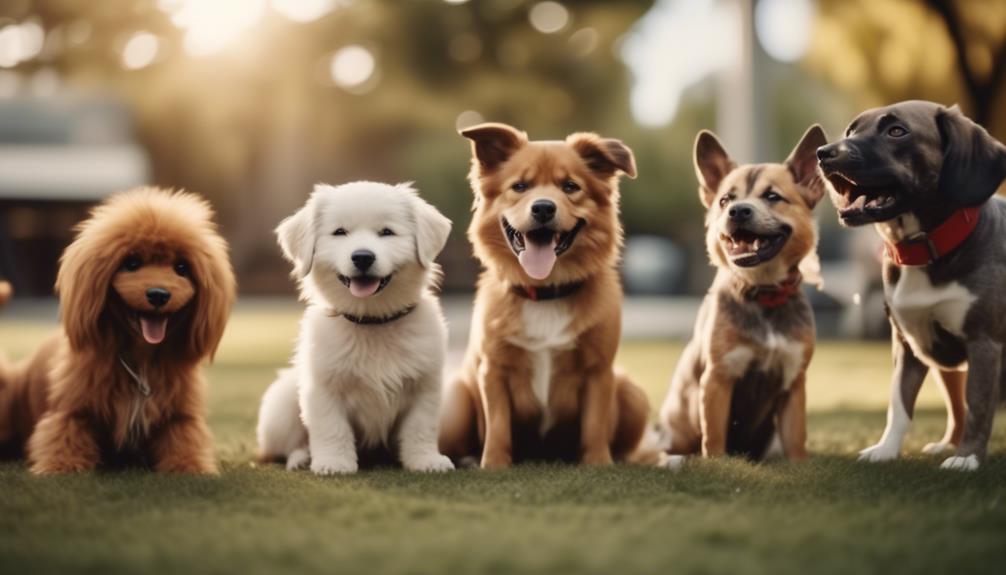What Are the Key Considerations When Choosing a Dog for a Multi-Pet Household?

Key considerations when choosing a dog for a multi-pet household include:
- Assessing existing pet dynamics
- Evaluating size and energy levels
- Considering temperament compatibility
- Age and gender factors
- Matching personalities
- Addressing health and medical needs
- Preparing for the introduction process.
Key Takeaways
- Assess the personalities, energy levels, and social behaviors of current and potential pets to ensure compatibility.
- Seek professional help if signs of aggression or dominance are present during initial interactions.
- Establish a harmonious relationship by considering complementary traits, play styles, and temperament.
- Choose a veterinarian who understands the needs of a multi-dog household and can provide appropriate medical treatments and vaccinations.
Assessing Existing Pet Dynamics
Assessing the dynamics among existing pets is crucial when considering adding a new dog to a multi-pet household. Introducing a new dog requires careful evaluation of the current dogs' personalities and needs. Each pet has its own unique temperament, energy level, and socialization preferences that can greatly impact the harmony within the household. By assessing the existing pet dynamics, one can make a more informed decision about choosing a dog that will fit well into the current family dynamics.
When assessing the existing pet dynamics, it's important to consider factors such as dominance and territoriality. Some dogs may have a dominant personality and may not tolerate the presence of another dominant dog. In such cases, it's advisable to choose a dog with a more submissive disposition. Additionally, territoriality can play a significant role in how well the pets will get along. Some dogs may be more possessive of their space and belongings, which can lead to conflicts with a new dog.
Furthermore, considering the compatibility of breeds is crucial. Different breeds have different temperaments and energy levels. It's essential to choose a dog that complements the existing pets in terms of energy and play styles. For example, if the current dogs are calm and prefer a laid-back lifestyle, introducing a high-energy breed may create tension and stress within the household.
Considering Size and Energy Level

When considering the addition of a new dog to a multi-pet household, it is important to carefully consider the size and energy level of the new dog in relation to the current pets. Matching the size and energy level of the new dog with your current dog's temperament and activity level is crucial for a harmonious household. It is essential to balance the energy levels of the dogs to avoid potential conflicts or stress.
To help dog owners make an informed decision, the following table outlines the considerations when choosing a dog with regards to size and energy level:
| Size | Energy Level |
|---|---|
| Small | Low |
| Small | Moderate |
| Small | High |
| Large | Low |
| Large | Moderate |
Considering the space and exercise needs of both dogs is vital when choosing a dog with a compatible size and energy level. A smaller dog may be a suitable choice for a household with limited space, while a larger dog may require more room to roam.
Furthermore, it is important to take into account the size difference between the dogs. Choosing a dog with a similar energy level to your current dog can ensure harmonious interactions and prevent any potential dominance or compatibility issues.
Evaluating Temperament Compatibility

To ensure a harmonious integration into a multi-pet household, it's essential to evaluate the compatibility of temperaments between your current dog and the potential new addition. Here are some key considerations for evaluating temperament compatibility:
- Assess the temperament of your current dog and potential new dog:
- Spend time observing their behavior, both individually and when they're together.
- Look for signs of aggression, fear, or anxiety.
- Observe how both dogs interact during initial meetings:
- Introduce them in a neutral territory and observe their body language and reactions.
- Are they comfortable around each other?
- Do they engage in appropriate play or show signs of tension?
- Look for complementary personalities and energy levels between the dogs:
- Consider taking into account factors such as age, size, and activity level.
- Dogs with similar temperaments are more likely to get along well.
- Consider the potential for territorial or resource guarding behaviors:
- Some dogs may exhibit possessive behaviors over toys, food, or space.
- It's crucial to address and manage these behaviors through training and socializing.
If you notice signs of aggression or dominance during the evaluation process, it's advisable to seek professional help. Remember, taking the time to evaluate temperament compatibility can greatly increase the chances of a successful and peaceful coexistence among your furry friends.
Age and Gender Factors

Consider the age gap between your current dog and the potential new addition when choosing a dog for a multi-pet household. Age plays a crucial role in the dynamics of a multi-dog household. It is generally recommended to introduce a new family member that is younger than the older dog. This age difference helps prevent potential behavior problems and allows the older dog to maintain their position as the alpha or leader of the pack.
Gender is another important factor to consider. Deciding whether to pair dogs of the same sex or opposite sexes depends on their past interactions. Some dogs may have a preference for interacting with dogs of the same gender, while others may get along better with dogs of the opposite sex. Observing how your current dog interacts with other dogs can provide insights into their gender preferences.
To help you make an informed decision, consider the following age and gender factors when introducing a potential new dog to your older dog:
| Age Gap | Gender Combination | Potential Interactions |
|---|---|---|
| Small | Same Sex | Easier to establish a hierarchy and reduce competition. |
| Small | Opposite Sex | May be less likely to compete for dominance. |
| Large | Same Sex | Potential for increased aggression and competition. |
| Large | Opposite Sex | May have a better chance of establishing a harmonious relationship. |
Matching Personalities

Matching personalities is an essential consideration when choosing a dog for a multi-pet household. It's important to ensure that the new dog's personality and temperament will be compatible with the existing pets. Here are some key factors to consider:
- Complementary Traits: Look for dogs with complementary traits to your current pet. For example, if you have an energetic and active border collie, a couch potato giant breed may not be the best fit.
- Compatible Play Styles: Consider the play styles of both dogs. Some dogs may prefer rough and tumble play, while others may be more gentle. It's important to find dogs that enjoy playing in a similar manner.
- Energy Levels and Social Behaviors: Assess the energy levels of both dogs. If one dog is high-energy and the other is more laid-back, it may lead to conflict or frustration. Additionally, consider their social behaviors and whether they're comfortable being around other dogs.
- Dominance and Resource Sharing: Evaluate the dominance level and willingness to share resources of both dogs. Some dogs may be more dominant and possessive of their toys or food, which can cause tension in a multi-pet household.
Addressing Health and Medical Needs

Addressing the health and medical needs of a new dog in a multi-pet household involves ensuring proper vaccinations, scheduling routine vet check-ups, and taking preventive measures for potential health issues.
When bringing a new dog into a multi-dog home, it's crucial to prioritize their health and well-being. One of the first steps is to make sure the new dog is up to date on vaccinations. This will help protect not only the new dog but also the existing pets from contagious diseases.
Scheduling routine vet check-ups is another important aspect. Regular visits to the veterinarian can help detect any underlying medical issues early on and ensure that the dog is receiving appropriate care. Establishing a relationship with a veterinarian who understands the specific needs of a multi-dog household can be highly beneficial.
Preventive measures, such as regular exercise, a balanced diet, and parasite control, are essential for maintaining the overall health of the new dog. Additionally, considering the pros and cons of dogs of similar energy levels and social skills can help create a harmonious environment.
If the new dog comes from a rescue group, it's important to obtain their medical history and address any existing health concerns.
Preparing for the Introduction Process

To ensure a smooth introduction process, it's important to establish a neutral meeting place for the dogs to interact at their own pace. Here are some things to consider when preparing for the introduction process:
- Choose a neutral meeting place: It's crucial to select a location that's unfamiliar to both dogs. This helps to prevent territorial behavior and allows the dogs to approach each other without feeling threatened.
- Allow for gradual interactions: Dogs need to make sure they feel comfortable with each other before being introduced fully. It's much easier if one dog is already familiar with the environment, as it can provide a sense of security for the new dog.
- Be patient and consistent: The introduction process may take time, and it's important to be patient. Allow the dogs to interact at their own pace and be prepared for multiple meetings if necessary. Consistently train both dogs for obedience to establish boundaries and expectations.
- Consider energy levels: Dogs of similar energy levels are more likely to get along well. If one dog is highly energetic and the other is more laid-back, it may require careful consideration and management to ensure a harmonious dynamic.
Frequently Asked Questions
What Are the Factors in Choosing a Dog?
When choosing a new dog, breed compatibility, size and energy level, temperament assessment, age and life stage, existing pet dynamics, training and socialization needs, health and medical considerations, time and commitment requirements, and long term financial implications are all important factors to consider.
What Are Considerations Getting a Dog?
When choosing a dog for a multi-pet household, considerations include compatibility with existing pets, size and energy level, breed characteristics, temperament and behavior, exercise and activity needs, training requirements, allergies and shedding, age and lifespan, and the time and commitment required.
What Is the Most Important Consideration When Adopting a Dog?
The most important consideration when choosing a dog for a multi-pet household is assessing compatibility with existing pets. Socialization skills, temperament, size, energy level, breed characteristics, training requirements, and special needs accommodation should also be evaluated.
What Selection Criteria Must We Consider Before Deciding to Get a Pet?
When choosing a dog for a multi-pet household, it is important to consider compatibility testing, existing pet dynamics, size and breed suitability, energy levels assessment, training and socialization needs, health and medical requirements, time and attention commitment, financial implications, and long term responsibility evaluation.









